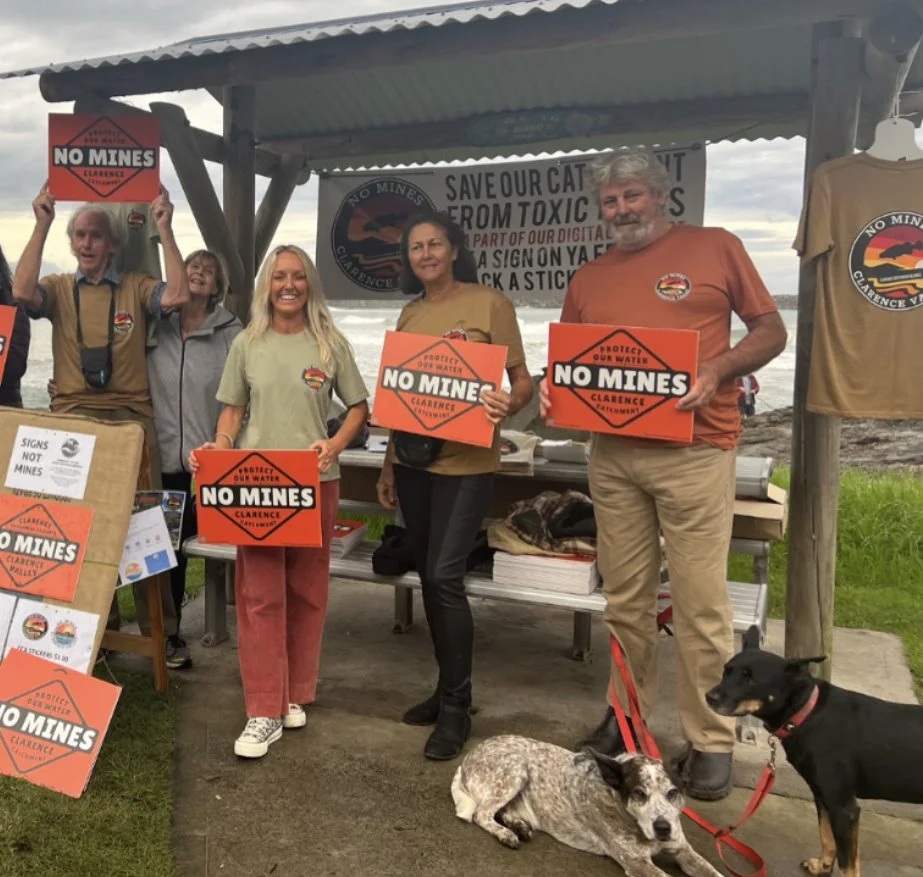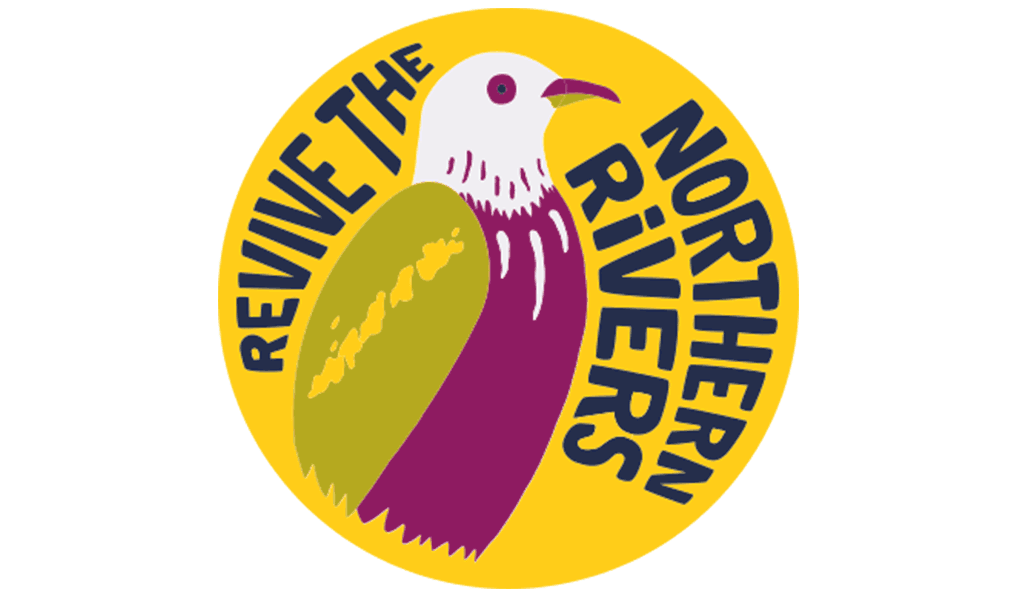
the campaign
the cca was the proud recipient of the 2024 clarence valley council Living sustainably ‘community group’ award.
Who we are
The Clarence Catchment Alliance (CCA) is based in the Northern Rivers of NSW, on Bundjalung, Gumbaynggirr, and Yaegl Country.
The CCA was formed in 2018 as a sub-group under the Clarence Environment Centre (CEC).
The CCA is a non-partisan, not-for-profit, run by volunteers that facilitates and amplifies the community’s call for a ban on mineral mining in the Clarence Catchment.
The CCA is dedicated to safeguarding the land, waterways, air and sea within the Clarence catchment.
We come from a place of care and protection
The CCA provides a unifying, supportive platform for our community’s concerns to be heard.
The CCA and community call for a ban on mineral mining in the Clarence Catchment due to the increased risk of water contamination in this high rainfall water catchment in a catastrophic flood zone.
The CCA calls for this ban due to the unique and high conservation, cultural, and economic value of the region, and the threat to the community’s environmental, cultural and economic wellbeing
The CCA calls for changes to NSW legislation to recognise the heightened risk of contamination in this flood zone, officially excluding the catchment from mining. We hope to set a precedent for other communities facing similar threats to their water catchments.
THE CCA
It's important to clarify that the CCA maintains a non-political stance and is independent of any party affiliations. Our primary objective is to garner support and collaborate with policymakers to effect changes in the Mining Act and the Mining SEPP, ultimately prohibiting mining activities in the Clarence Catchment.
Given the specific focus of our mission and the diverse range of threats facing our local rivers, our campaign exclusively targets the issue of mining. While numerous groups are engaged in safeguarding water resources from many threats, our sole concern revolves around mining activities.
The community's collective voice calls for legislative amendments to safeguard areas of unique ecological importance, water catchment zones, and culturally significant areas, particularly within flood-prone regions of the catchment.
The CCA was formed to unite many smaller groups across the catchment rallying on this issue. the “Alliance” was formed to streamline, strengthen, and better facilitate the communities at risk.
Since then, the CCA has continued to form broader allies with other community groups and organisations to protect, care and save our environment. UNITED we are stronger and better equipped to provide a voice for those who cannot speak for themselves like our rivers, oceans, country and species.
The CCA, its members, and supporters come from a place of care and protection. Everything that relies on clean water and the survival of our pristine rivers is the driving, and unifying force.
CCA members and supporters are from a broad cross-section of the local community and across Australia.
Clarence Valley Council supports the ban on mining in the Clarence, as do the neighbouring councils of Glen Innes Severn, Kyogle, Byron Shire, Coffs Harbour, and Bellingen Shire. Each have formal standing resolutions on this issue.
High-profile Australians from the arts, sport, music, entertainment, politics, business, and enviro lobbying have lent their support publicly to the campaign as well. These can be found in our allies hub.
In 2021 our 10,000+ signature petition was debated in the NSW Legislative Assembly. Speakers in support of the petition the CCA’s reasoning for a ban on mining in the catchment. The debate can be viewed here.
Speakers against the community petition stated mining was needed in the region for growth and to provide jobs. They failed to acknowledge the thriving, existing, local industries that are heavily reliant on clean water.
These MPs know our region is an abundant food bowl of prime agricultural land, a commercial fishing and prawning haven of flourishing aquaculture and habitats, and a world-class river-based eco, outdoor, and nature tourism hotspot.
If mineral extraction licences are approved, and if tailings dams fail or leach, these local industries could be decimated, and the social and economic impact deeply felt by locals.
THE CLARENCE CATCHMENT ALLIANCE CALLS FOR
A ban on mineral mining, both exploratory or active, in the Clarence Catchment and surrounding Local Government Areas that feed its water source.
A cease to be put on the renewal or granting of exploratory (EL) and mining licenses (ML) and all existing exploratory (EL) and mining licenses (ML) to be revoked.
We call for this in recognition of the Clarence Catchments importance for threatened species and ecological communities, such as the Eastern Freshwater Cod, Platypus, and Koala.
The heightened risk of contamination in a known flood zone.
The reliance on water and rivers for the community’s environmental, cultural and economic wellbeing.
Amendments to the NSW State Environmental Planning Policy (Mining, Petroleum Production and Extractive Industries) 2007 to add the following as prohibited development:
mineral mining and mineral exploration in the Clarence Catchment and surrounding Local Government Areas that feed its water source.
Amendments to the NSW Mining Act 1992 to prevent mining and mineral exploration occurring in major urban drinking water catchments, culturally and environmentally sensitive areas, and across the Clarence Catchment and surrounding Local Government Areas that feed its water source.
CCA calls to action provide a variety of ways to lend your voice to protect our water, save our rivers and care for our catchment. If you’d like to give back please fill in our volunteer form.
The Problem
2023 Licence summary compiled by the CCA. There have been more Exploratory Licences (ELs) approved since. Updates coming soon.
The Clarence Catchment is under threat from mineral mining with explorations across the area underway.
There are 40+ Exploration Licences (ELs) in the area. The mine sites are in delicate water catchment areas beside the Clarence, Mann, and Nymboida Rivers and on the Dorrigo Plateau, a drinking water source for the Clarence, Coffs, & Bellingen shires. The unique biodiversity of the area includes threatened species such as the Koala, Eastern Freshwater Cod, and Platypus.
If approved local plateaus could be reduced to rubble and the community’s water potentially poisoned by chemical and acidic runoff.
Regular heavy rains and recent catastrophic floods show how quickly water moves from upriver, through towns, and into the ocean, and highlight how risky mine tailings dams would be in this area. Water is the community's common thread and the essential source of the 175+ years of local water-reliant heritage industries. Local seafood, dairy, sugar cane, livestock, crops, and tourism, and the industries that service them, need clean water.
No promise of mining jobs can outweigh the potential decimation of the millions of dollars & employment the local water-reliant sectors already provide.
The Clarence Catchment is home to 57,016 people, 4,387 of which are First Nations People with deep cultural ties to the Clarence Catchments Rivers and surrounds.
The catchment enjoys some of the most diverse pristine natural geographical features, marine and land fauna and flora species, habitats, waterways, wild rivers, catchments, estuaries, and beaches in Australia, many of which are unique to this area due to the MacPherson Macleay Overlap.
It is world-famous for its temperate sub-tropical climate, relaxed nature-based lifestyle, county-coast hospitality, historical towns and industries, boating, surfing, camping, fishing, deep cultural ties to water, and top-quality seafood, beef, cane, blueberries, macadamias, and food bowl produce. Locals pride themselves on sharing the sheer beauty and health of their home with millions of tourists and visitors annually.
The community is socially and culturally rich, environmentally sound, employed, and economically successful because of the health of the Clarence’s ecosystems and water sources. “We are water people, and our rivers are the lifeblood and backbone of our community. This would be placed at great risk if mineral extraction was approved, and contamination was to occur.
The pursuit of rare earth minerals in this delicate ecosystem not only jeopardises its natural balance but also endangers the very lifeline of the region – its water. The consequences of unchecked mineral mining activities in this area could be catastrophic, leading to irreversible damage to water quality, aquatic life, and the livelihoods and deep cultural ties of those dependent on these resources.
Failed tailings dams pose a particularly grave risk to the waterways of the Clarence Catchment. These dams, designed to contain the toxic byproducts of mineral processing, can unleash a torrent of pollutants into the surrounding environment when they fail. Heavy metals, acids, and other harmful substances leach into the water, contaminating it and rendering it unfit for consumption or use. The repercussions of such contamination extend far beyond the immediate vicinity of the dams, affecting downstream communities, agriculture, and ecosystems. Dust rising from sites is also a contaminant and air quality is reduced significantly. Rainwater tank testing near NSW’s Cadia gold mine uncovered unsafe levels of mercury
Australia has witnessed several alarming instances of mineral mining tailings dams failures, each leaving a devastating imprint on the water resources of the affected regions. Examples include the Queens River in Tasmania which is known as pumpkin soup river due to the orange copper mine runoff and uninhabitable water. Mount Lyell copper mine disaster in Tasmania, where a tailings dam breach in 2014 unleashed a toxic slurry into nearby waterways, decimating aquatic life and leaving a lasting legacy of pollution. Similarly, the Cadia gold mine in New South Wales experienced multiple breaches of its tailings dams, leading to the release of toxic substances into the environment and contaminating groundwater sources. Other notable incidents include the Ok Tedi copper mine in Papua New Guinea, owned by an Australian company, which released millions of tons of tailings into the Fly River, causing widespread ecological damage downstream. These examples serve as stark reminders of the grave consequences of irresponsible mineral mining practices and underscore the urgent need for stringent regulations and environmental stewardship in safeguarding our precious water resources.








